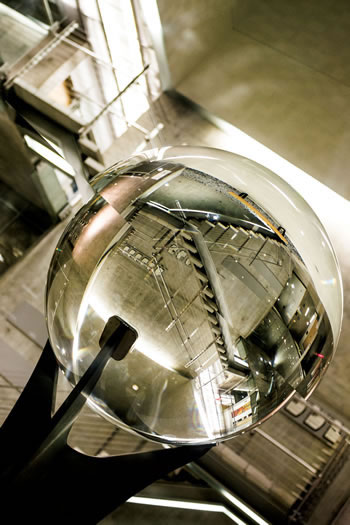Optical Sciences & Engineering: Lighting the Future
Optical engineers use lasers, lenses, spectrometers, and other light-manipulating systems to design equipment for consumer products, manufacturing, medicine, communications, space exploration, and quantum engineering.
The University of Arizona Wyant College of Optical Sciences is one of the premier educational and research institutions in optics and photonics worldwide. We focus on educating outstanding students with a broad foundation in all areas of optics and on providing practical experience and highly competitive technical skills. Our research program spans from optical engineering to fundamental optical physics, from photonics to image science, and provides unique opportunities to pursue cutting-edge applications of optics in real systems. Our alumni become engineers, entrepreneurs professors, and scientists; working in academia, industry, government, and business around the globe.
Academics > Research Opportunities > Outside the Classroom > Career Paths >
The UA is part of the Integrated Photonics Institute for Manufacturing Innovation (AIM Photonics), which was extended in early 2022 to continue its efforts in the design and manufactur of integrated photonics.
The Wyant College of Optical Science’s leads the UA’s effort in Quantum Engineering through the NSF Center for Quantum Networking.
Academic Focus Areas
The optical sciences and engineering major has five tracks that meet your specific interests:
- Optics: upper-division optics courses to accommodate your interests
- Optoelectronics: integration of optics and electronics technologies
- Optical materials: study of optical materials, such as glass and semiconductors
- Optomechanics: manufacture and packaging of optical systems to very high standards
- Biomedical Optics: connection of optics to medical and biological sciences
Research Opportunities
UA optical engineering research includes
- Ultrahigh-capacity optical fiber technologies for the Internet
- Hand-held ophthalmic devices for vision improvement and remote patient exams
- Heads-up displays for transportation, including pilots and drivers
- Virtual and augmented reality displays
- State-of-the-art optical design for microlithography (i.e., computer chips)
- Solar energy systems technologies
- Lidar for automated driving and sensing our atmosphere
- Distributed and remote optical sensors for measuring the world around us
- Developing new methods of solid-state lighting using LEDs and lasers
- Exploring future data storage techniques
- Fabrication of optics through diamond turning, molding, and lithography
- Quantum engineering for improved communications, imaging, and computing
- Creating additive manufacturing techniques using optics
- Developing new ways of viewing the universe through telescopes and spectrometers
- Creating lasers that can machine, mark, and process metals and plastics
- Developing metrology equipment to nanometer precision
- Developing new technologies for medical imaging
- Endoscope design for cancer detection and treatment
- Validating and preserving ancient artworks by Vincent Van Gogh
Optics leads us into the 4th industrial revolution, in which the integration of optics technology into the world that surrounds us. Essentially, if some system or component uses light, it and associated technologies are being studied in the Wyant College of Optical Sciences.

Outside the Classroom
In addition to the many research opportunities and innovation opportunities, UA optical science engineers enjoy many professional development advantages and community outreach activities through Women in Optics and the Student Optics Chapter. The groups do outreach, have biweekly meetings, and arrange large scale events. Learn more about optics-focused clubs and societies.
Optical Sciences and Engineering students receive numerous internship offers from a wide range of companies, including Northrop Grumman, Meta, Amazon, Raytheon, Apple, Microsoft, Boeing, National Labs, DOD Labs, ASML, Arizona Optical Metrology, Aerospace Corporation, Edmund Optics, Synopsys, Zemax, Quantinuum, MIT Lincoln Labs, and many others. There are also a number of opportunities for research experience at other institutions (REUs) and study abroad in locations such as Taiwan and Germany.
Career Paths
Graduates are ready to work in optical design, optical fabrication and testing, lasers, optical detectors, optical instrumentation, and optical fiber communications, to name only a few career opportunities. Graduates are also ready to pursue higher degrees and an academic or research career spanning opportunities in medical research to astronomy research.
Optical engineers do research and development in medicine and the military, develop new optics for space telescopes, improve fiber optic systems, and design metamaterials with unique optical properties. The opportunities and range of careers is expansive – if you can think of it, there is an opportunity! The US median salary (2022 report) is $145,000 (for-profit), $104,500 (academic), and $130,000 (all). Starting median salary in the US is over $70,000, over $90,000 by year five, and $120,000 after ten years.
Additionally, the Wyant College of Optical Sciences offers the unique opportunity to connect with alumni and professionals in the field through the Wyant College Industrial Affiliates Program. Twice a year, over fifty companies from all over the world flock to Tucson, AZ to meet and recruit the students of the Wyant College of Optical Sciences.
Learn more about how you can be part of lighting the future by contacting us today!


